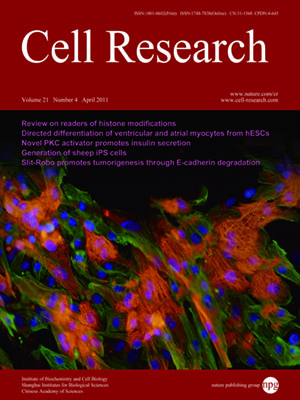
Volume 21, No 4, Apr 2011
ISSN: 1001-0602
EISSN: 1748-7838 2018
impact factor 17.848*
(Clarivate Analytics, 2019)
Volume 21 Issue 4, April 2011: 642-653
ORIGINAL ARTICLES
Transcriptional activation of endoplasmic reticulum chaperone GRP78 by HCMV IE1-72 protein
Derick Shi-Chen Ou1,2, Sung-Bau Lee2,*, Chi-Shuen Chu2,*, Liang-Hao Chang2, Bon-chu Chung1,4 and Li-Jung Juan2,3
1Institute of Molecular and Cellular Biology, National Tsing Hua University, 101, Section 2, Kuang-Fu Road, Hsinchu 300
2Genomics Research Center, Academia Sinica, 128 Academia Road, Section 2, Nankang, Taipei 115
3Institute of Molecular Medicine, National Taiwan University, No.7, Chung San South Road, Taipei 100
4Institute of Molecular Biology, Academia Sinica, 128 Academia Road, Section 2, Nankang, Taipei 115
Correspondence: Bon-chu Chung, Li-Jung Juan,(mbchung@sinica.edu.tw; ljjuan@gate.sinica.edu.tw)
Glucose-regulated protein 78 (GRP78), a key regulator of endoplasmic reticulum (ER) stress, facilitates cancer cell growth and viral replication. The mechanism leading to grp78 gene activation during viral infection is largely unknown. In this study, we show that the immediate-early 1 (IE1-72) protein of the human cytomegalovirus (HCMV) is essential for HCMV-mediated GRP78 activation. IE1-72 upregulated grp78 gene expression depending on the ATP-binding site, the zinc-finger domain and the putative leucine-zipper motif of IE1-72, as well as the ER stress response elements (ERSEs) on the grp78 promoter. The purified IE1-72 protein bound to the CCAAT box within ERSE in vitro, whereas deletion mutants of IE1-72 deficient in grp78 promoter stimulation failed to do so. Moreover, IE1-72 binding to the grp78 promoter in infected cells accompanied the recruitment of TATA box-binding protein-associated factor 1 (TAF1), a histone acetyltransferase, and the increased level of acetylated histone H4, an indicator of active-state chromatin. These results provide evidence that HCMV IE1-72 activates grp78 gene expression through direct promoter binding and modulation of the local chromatin structure, indicating an active viral mechanism of cellular chaperone induction for viral growth.
Cell Research (2011) 21:642-653. doi:10.1038/cr.2011.10; published online 11 January 2011
FULL TEXT | PDF
Browse 2304


